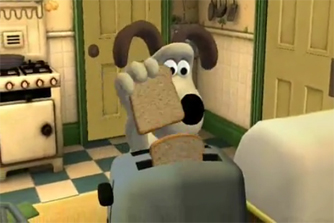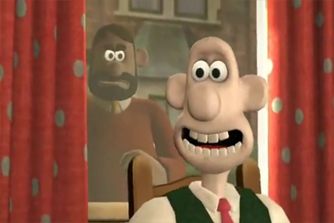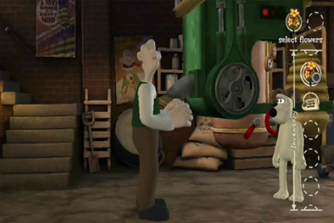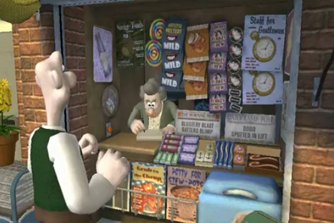Let me start by saying this: Having now played Wallace & Gromit’s Grand Adventures: Episode 1 – Fright of the Bumblebees on the Xbox 360, I think Telltale Games might be my new favorite videogame developer.
OK, I’ll backtrack a little to put that statement into context.
Although I enjoy a variety of videogame genres, my greatest love is—and probably always will be—adventure games, more specifically of the point-and-click variety popularized in the late-80s/early-90s by PC behemoths Sierra and LucasArts. (This shouldn’t come as a big surprise to anyone who’s read my regular GameCola column, “testgame.exe: Making the Adventure.”) Unfortunately (for me), adventure games aren’t made that much anymore, the reasons for which various GameCola writers have recently discussed.1
So when I picked up the first installment of Telltale Games’ new four-part episodic series of adventure games (not technically “point-and-click,” but more on that later), I was excited, but also trying really hard not to get my hopes up as I recalled adventure games of yore. It turns out I didn’t need to be worried: Fright of the Bumblebees is, quite simply, a great adventure game.
This game takes the player into the world of Wallace & Gromit, starring a clay (or, technically, plasticine) comedic duo who first appeared in three animated shorts on British TV in the early 90s and have since become darn famous, winning Oscars, starring in movies, and so on.2 Over the course of the game, you alternate between controlling Wallace, a middle-aged, middle-class inventor/entrepreneur, and his faithful dog Gromit, who, in many ways, is smarter than his master, but is, well, a dog. Each of the game’s acts establishes a goal that one of the heroes must accomplish while the other is indisposed, and each act builds upon the previous acts, creating a cohesive overall story. In true Wallace & Gromit form, the story starts with some brilliant ideas from Wallace, continues with those ideas going horribly wrong, and ends with a climactic chase scene. And there are giant bees.
The gameplay in Fright of the Bumblebees mostly follows the standard adventure game formula (and when I say “formula,” I do not mean that in a negative way): Wallace and Gromit take turns exploring the environment, talking to other characters, gathering items, and solving puzzles in order to achieve their goals. The puzzles in this game are awesome—they successfully walk the line between too hard and too easy, and they are consistently clever, intuitive, and tricky without ever being annoying. Some of the puzzles had me pondering for quite a while, but I managed to finish the game without assistance. For those moments when a little help is necessary, however, the game comes with a potentially very useful in-game hint system, in which a character makes progressively more specific comments about the solution to a puzzle (think UHS). The frequency of these hints can be adjusted at any point in the game on a scale from “often” to “never,” so the flexibility of the gameplay experience is pretty deep.
Much like the puzzles in this game, the various interactions with objects and characters are also awesome.3 This is, after all, a comedic game, and the dialogue does everything it can to make you laugh out loud. And you will. Frequently. This is true even during the portions of the game in which you control Gromit, who, as a rule, doesn’t speak. When examining something as Gromit, you often get a perfectly timed comment from Wallace if he’s in the same (or even better, a different) room. In the absence of a spoken comment, Gromit’s body language and facial expressions convey everything we need to know and are sometimes even funnier than anything that could have been said with words.
Another great aspect of this game—one that many adventure games have (thankfully) taken as a basic tenet—is that there’s no risk of dying or running into a dead-end. Without having to worry about the game ending badly/prematurely, you’re free to enjoy the game and just have fun. This doesn’t mean, however, that there’s any lack of tension or excitement—Fright of the Bumblebees has action a-plenty, but the excitement comes from involvement with the characters and their world rather than from fear of failure.
We also get some variety in gameplay with a small porridge-shooting minigame. I usually get upset when adventure games try to squeeze in minigames, but this seems to work well and makes perfect sense in context (and it’s not even really a “game” as such [unless you’re trying to get Xbox Achievement Points…], just a different way of interacting with the game world).
So that’s the so basically of this game on its own. But since it’s not just a game, but a licensed game, one of the most important aspects of Fright of the Bumblebees is how well it successfully fits into and plays off of the Wallace & Gromit world that we all—read: I—know and love.4
So just before I sat down to play this game, I made a short list of things that I needed to see in any Wallace & Gromit story for it to feel authentic. Call it a test, if you will, that the game had to pass before I could give it the Wallace & Gromit Stamp of Approval (which I am undoubtedly licensed to award). This list went as follows:
1) Cheese.
2) Wallace inventing things (usually complicated machines for simple tasks).
3) Gromit doing domestic/household activities.
Within the first five minutes of gameplay, I had checked off everything on my extremely authoritative list. Wallace’s inventions pepper the story throughout, from a cheese-sniffing robot mouse (That’s a check for #1 as well! Bonus!) to a mechanical zip-line system for bringing him his pen. The entire first act of the game has Gromit on a quest to prepare Wallace’s breakfast. The requisite cheese prevalence could have so easily been forced—I’m thinking a “collect the hidden cheeses!” minigame—but instead, cheese is smoothly incorporated as a critical aspect of certain puzzles and a natural part of Wallace’s dialogue. So Fright of the Bumblebees passed the initial test! But how does it fare in the more detailed aspects of Wallace & Gromit-ness?
In short, I am incredibly impressed as to how much work the people at Telltale Games must have put into making this game look and feel like a Wallace & Gromit film. The characters—particularly our familiar heroes—walk, gesture, and behave exactly as they do in the original claymation films. On top of that, the characters look just like their clay counterpoints, complete with a molded-clay skin texture, mouth movements with a small number of frames, and even those little holes in the centers of their eyeballs.5 The boundaries between the playable and non-playable parts of the game (i.e. cutscenes, dialogue, etc.) are almost invisible; it actually does end up feeling like you’re playing a movie. The overall effect is so subtle that you might not even notice it, a great feat considering this is a videogame, and not a claymation film. Again, the people at Telltale Games really did their research here, and the game is all the better for it. 6
The music in the game is playful and jazzy and takes its cue from the traditional Wallace & Gromit theme that plays during the beginning and end of the game. The background music is almost always present, sets just the right mood, and does so dynamically—I even noticed a drum roll sneaking into the mix during a particularly response-sensitive puzzle, which I thought was way cool.7
Like the music, the voice acting in the game is top-notch. It is a little disappointing that Peter Sallis, who voices Wallace in all the films, did not reprise his role in this project. The voice actor who replaces him, however, provides a performance that is undoubtedly still Wallace, and is very close to Sallis’s original. For anyone who has trouble understanding the thick Yorkshire accents that Wallace & Gromit characters traditionally sport, by the way, there’s a convenient subtitle option that could come in handy.
The one part of this game that I might criticize is the controls. You control the characters using one analog stick to walk, and the other (or the LB and RB buttons) to select objects or people in the environment to interact with. I found the controls to be intuitive enough—especially once I discovered the LB and RB buttons, which basically allow you to cycle through all possible interactions on the screen, instead of trying to awkwardly aim toward an object with the analog stick—but they definitely take some getting used to. I couldn’t help thinking that it might have been easier to just include a point-and-click interface (and I’d like to think that’s not just my inner adventure game purist speaking). The PC version of the game, in fact, does make use of pointing-and-clicking for interactions, but still uses the keyboard arrows to move the main character.
As far as replay value goes, there’s not much incentive to play the game again—there aren’t any alternate endings or new game plus modes, or anything like that. The Xbox 360 version, however, adds the inevitable Achievements, some of which almost certainly require multiple playthroughs if you want to get all the points possible (and I mean, that’s why people play videogames now anyways, right?). The Xbox Leaderboards do something interesting as well: your placement on the boards is determined by the number of unique dialogue entries you’ve heard overall in the game, so by playing the game multiple times and seeking out new instances of dialogue, you get to move up through the ranks of Fright of the Bumblebees elite. For those of you who are interested in that sort of thing.
Assessing this game’s novelty is giving me some difficulty, so I’ll walk you through my thought processes here. On the one hand, it’s novel enough in that it’s the only non-Community Game adventure title (I think) on the Xbox 360. On the other hand, it’s strongly rooted in the point-and-click adventure genre of the past. But back on the first hand, the puzzles and gameplay all feel fresh and interesting, and I’ve never seen anything quite like the Gromit-controlled gameplay. So I’m giving the game a reasonably more-than-average novelty score.
Fright of the Bumblebees is, simply put, just about the perfect Wallace & Gromit adventure game. It fits exceptionally well within the existing Wallace & Gromit world, but it’s also a funny, engaging, and well-crafted game in its own right. And you don’t need to be familiar with the characters before playing the game. It’s a fairly short game (~4 hours from beginning to end), but it’s just the first of four adventures (the second of which is already available for the PC), and it’s well worth $10 on Xbox Live Arcade. You can bet I’ll be picking up the other three games as soon as they’re released!
So yeah, I love Telltale Games. I think they did a phenomenal job with this game (she says for the 5,000th time), and from what I’ve gathered, their Sam & Max and Homestar Runner games are awesome as well. Now what I’d love to see them do is work with an original IP. I can’t help but think that, since they’ve proven that the adventure game genre is still viable, they could make something new and exciting that none of us have ever seen, and it would be amazing… But there’s no hurry.8 And until then, I’ll keep playing their games and having a great time doing so. 🙂
1. On the podcast last month, Paul Franzen blamed “the death of the adventure game” on companies pushing their games to use (ugly) 3D graphics and (bad) direct keyboard controls in the late 90s. I’d like to point out another potential factor: the incorporation of RPG/fighting elements. See, for example, King’s Quest VIII. Yeah.
2. There have been two other Wallace & Gromit games (Project Zoo and Curse of the Were-Rabbit), but, as I’ve never played either of them (and one was a movie tie-in, so it probably doesn’t even count), I won’t be referring to them here. I think it’s safe to assume, however, that they’re pretty different from the game in question.
3. Two things that are both awesome. What a great segue.
4. If you’re not already familiar with Wallace & Gromit, I highly recommend that you watch their best (and yes, that’s objective, not subjective) short films as soon as possible: The Wrong Trousers and A Close Shave. You won’t regret it.
5. You know what I’m talking about, right? I think they’re traditionally there in real clay models to allow animators to move the characters’ eyes between frames. I would show you a picture of the little holes in action, but alas, the Internet is failing me right now.
6. There are even plenty of gentle nods to previous Wallace & Gromit adventures for those of us in the know: The mechanical trousers make an appearance, as does a door from Wallace’s rocketship, and a picture of a sheep (Shaun, perhaps?) hangs in a hallway.
7. Technically, I didn’t hear the drum roll every time I tried to solve this puzzle, but I’d like to think that it wasn’t just a fluke.
8. Especially with the new Monkey Island games coming out!





